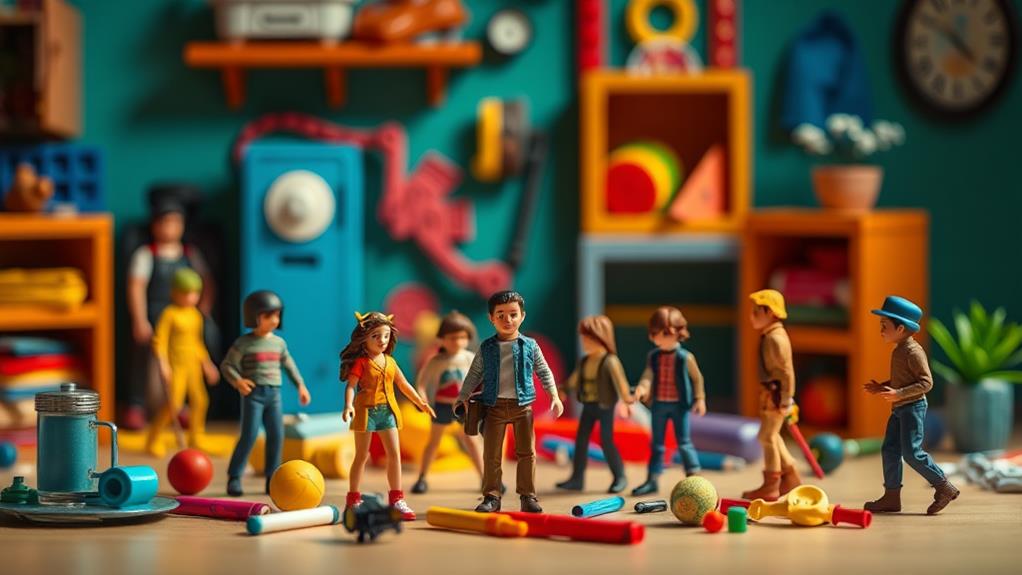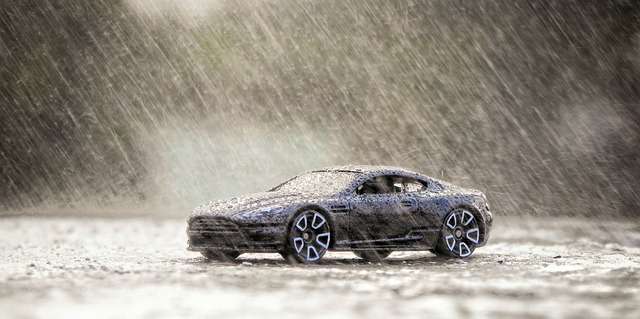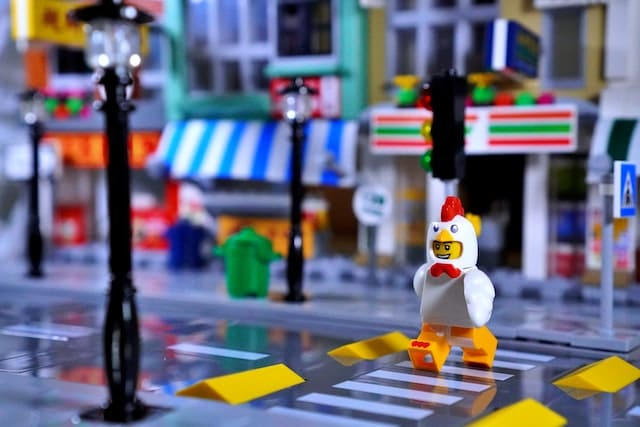Using perspective tricks in toy photography helps you create enthralling, lifelike scenes that draw viewers into a tiny world. You can enhance depth and dimension by experimenting with camera angles and focal lengths. These techniques also allow you to craft unique storytelling angles and simulate realistic environments with everyday props. By manipulating light and shadow, you increase drama and highlight intricate details. Playing with scale and proportion challenges perceptions and adds dynamic visual interest. This approach amplifies emotional impact, inviting viewers to connect deeply with your images. There's plenty more to uncover about how perspective can transform your toy photography.
Enhancing Depth and Dimension
Enhancing depth and dimension in toy photography involves playing with perspective to make your miniature subjects appear more lifelike. By manipulating angles and distances, you can create a sense of scale and realism that captivates the viewer. Start by positioning your camera at a low angle, which makes toys look larger and more imposing. This technique mimics how you naturally view objects in the real world, adding authenticity to your shots.
Experiment with various focal lengths to achieve different effects. A wide-angle lens can exaggerate distance, creating a dramatic sense of depth, while a macro lens can focus on intricate details, bringing your subjects to life. Don't hesitate to move around your subject, trying shots from different positions. This flexibility allows you to discover the most compelling perspective.
Layering is another powerful trick. Place objects in the foreground, middle ground, and background to add complexity to your composition. This layering creates a visual journey for the viewer's eye, enhancing the overall storytelling of your image. Remember, the goal is to make the small world of toys feel as immersive and dynamic as the one outside your camera's frame.
Creating Dramatic Visual Effects
When it comes to creating dramatic visual effects in toy photography, the right use of lighting and shadows can transform your shots from ordinary to extraordinary. By manipulating these elements, you can add intensity and intrigue to your compositions. Start by experimenting with different light sources, such as natural sunlight or specialized photography lights. Positioning your light source at various angles can create striking contrasts and emphasize the textures and details of your toys.
Shadows play an essential role in adding depth and drama. You might tilt your light to cast longer shadows, giving your scene a more dynamic and mysterious feel. Using a flashlight or smartphone light, you can create sharp, defined shadows that make your toy subjects appear more lifelike and engaging. Don't hesitate to try colored gels or filters over your lights to introduce mood-enhancing tints.
Another trick is to use reflective surfaces like mirrors or water to bounce light back onto your subjects, creating a halo effect or softening harsh shadows. This technique can highlight specific areas, drawing the viewer's eye to important details. Remember, the goal is to evoke emotion and captivate your audience with your creative vision.
Crafting Unique Storytelling Angles

Crafting unique storytelling angles in toy photography requires a blend of creativity and perspective. You’re not just taking photos of toys; you’re creating entire worlds and narratives. By experimenting with angles, you can transform a simple scene into an epic tale. Imagine a tiny toy soldier scaling a mountain of books or a superhero leaping from one coffee cup to another. The angle you choose dictates the story’s flow and the viewer’s perception. In this exhilarating journey, exploring unconventional toy photography angles can lead to unexpected and mesmerizing results. Low-angle shots can make toys appear larger than life, while high-angle perspectives might evoke a sense of vulnerability or isolation. By actively seeking out these creative viewpoints, you not only showcase your toys in surprising ways but also invite your audience to engage with the narrative, sparking their imagination to fill in the gaps and create their own stories.
Perspective tricks allow you to play with scale and focus. Shooting from a low angle makes your toys appear larger and more heroic, while a high angle can make them seem small and vulnerable. You can also use forced perspective to create interactions between toys and real-world objects, giving the illusion that these miniature figures are part of our everyday lives. This technique can evoke emotions and bring your stories to life.
Think about the story you want to tell. Is it a playful adventure or a dramatic showdown? The angle you choose can enhance the mood and emphasize key elements. By carefully considering your approach, you can craft compelling narratives that captivate and engage your audience.
Simulating Realistic Environments
While crafting unique storytelling angles sets the stage for your toy photography, simulating realistic environments breathes life into your scenes. Imagine your toys as actors on a miniature set, each requiring a believable backdrop to truly captivate viewers. By carefully selecting and arranging props, you can create worlds that feel authentic and immersive, drawing your audience into the narrative you're crafting.
Start by considering the setting your toy naturally belongs to—a jungle, a bustling city, or perhaps a serene beach. Use everyday items to construct these environments. For instance, cotton balls can mimic clouds or fog, while sandpaper can become a desert landscape. Don't hesitate to experiment with different textures and colors to achieve the desired effect.
Lighting is your secret weapon. Adjusting light sources can transform a simple scene into something dynamic and engaging. Use natural light to create soft, realistic shadows or place a lamp strategically to highlight key elements.
Perspective tricks enhance realism, making toys appear life-sized. Position your camera at toy eye-level to create depth and intimacy. With practice, you'll find the perfect balance between props, lighting, and perspective, turning simple toys into extraordinary storytellers.
Highlighting Toy Details Creatively
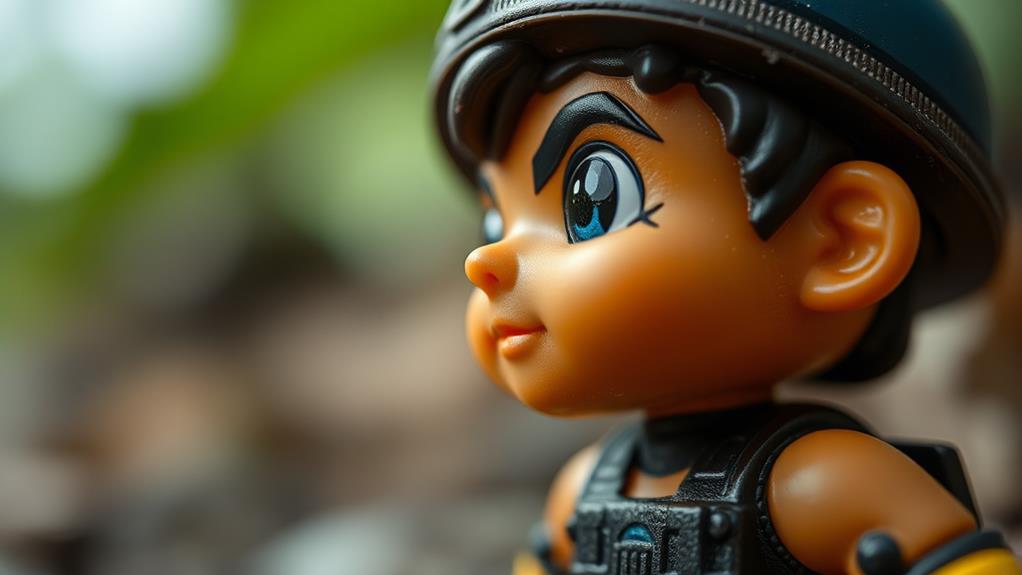
Capturing the intricate details of your toys can elevate your photography from simple snapshots to stunning works of art. By focusing on creative techniques, you can highlight these details in ways that draw viewers into your miniature world. Start by experimenting with different angles. Shooting from a low angle can emphasize a toy's stature, while close-ups can showcase the fine craftsmanship of its features.
To enhance details, consider the lighting. Natural light can bring out textures and colors that artificial lighting might miss. Play with shadows and highlights to create depth and dimension, giving your toys a more lifelike appearance. Reflectors or small lamps can also help you control and direct light precisely where you need it.
Use props to complement your toys without overshadowing them. A simple backdrop or small accessories can add context and intrigue, emphasizing the toy's details. Additionally, post-processing tools like photo editing software can refine your image, enhancing colors and sharpness to make those details pop.
Playing With Scale and Proportion
Playing with scale and proportion in toy photography can transform your images from ordinary to extraordinary. By manipulating these elements, you create a new world where tiny figures appear life-sized, or everyday objects dwarf toy figures. This technique adds depth and dimension to your photos, drawing viewers into the scene and making them question reality. Imagine a toy car racing down a real highway or a tiny action figure scaling a massive coffee mug. These playful combinations captivate and amuse anyone who sees them.
To master this, focus on camera angles, focal points, and backgrounds. Here's a quick guide:
| Element | What to Do | Effect |
|---|---|---|
| Camera Angle | Shoot from ground level | Makes toys appear larger |
| Focal Point | Use selective focus | Highlights specific details |
| Background | Choose large objects | Enhances the illusion of scale |
Experimenting with these techniques can lead to surprising and delightful results. By adjusting your camera angle and playing with the environment, you'll craft scenes that seem almost magical. Remember, the key is to view the world through the eyes of your toys, letting their tiny adventures unfold in a big, beautiful way.
Amplifying Emotional Impact
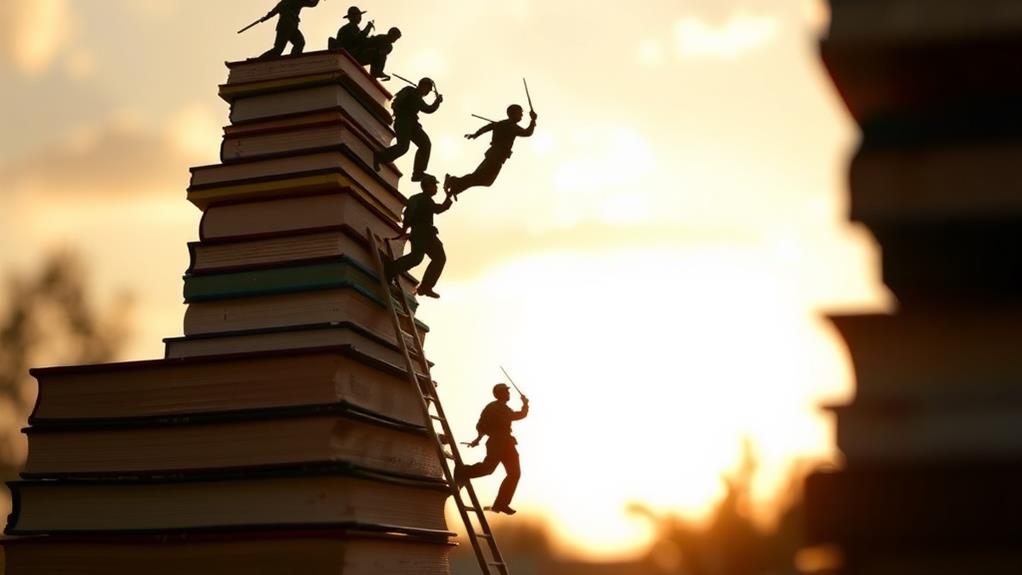
To truly captivate your audience, amplify the emotional impact of your toy photography. Perspective tricks can transform a simple scene into a powerful narrative that resonates with viewers. By manipulating angles and viewpoints, you can evoke emotions such as nostalgia, excitement, or even tension. Consider how the angle of a shot can change the viewer's perception. A low angle might make a toy figure appear heroic and grand, while a high angle can convey vulnerability or smallness.
Use depth of field to your advantage. Blurring the background or foreground can draw attention to the subject, highlighting its expression or action. This technique helps focus the viewer's emotional response on the intended element, making the scene more poignant. Playing with lighting and shadows also adds drama, creating moods that can range from comforting to eerie.
Don't forget the power of storytelling. A simple change in perspective can suggest a narrative, prompting viewers to imagine the story behind the image. By engaging their imagination, you create a deeper connection. Remember, every choice in your composition should serve the story you want to tell and the emotions you wish to evoke.
Inspiring Innovative Compositions
While perspective tricks amplify emotional impact, innovative compositions breathe life into your toy photography, sparking curiosity and wonder. By experimenting with angles and arrangements, you reveal endless creative possibilities. Imagine a toy soldier scaling a mountain of books or a superhero leaping from a cereal box skyscraper. These setups create dynamic stories within a single frame, engaging viewers and encouraging them to explore each detail.
To inspire innovative compositions, start by observing your environment. Everyday objects can transform into extraordinary landscapes or urban jungles. Use reflections in mirrors or water to add layers and depth to your shots. Play with scale by juxtaposing large and small elements, making the toys appear alive in their miniature world.
Lighting also plays a critical role in composition. Experiment with shadows and highlights to direct attention and evoke mood. Try shooting during different times of the day to capture varying light qualities, adding drama or serenity to your scene.
Ultimately, the key to inspiring compositions is to think outside the box. Challenge yourself to see the world through the eyes of your toys, and let your imagination guide your lens.
Frequently Asked Questions
How Can Perspective Tricks Benefit Photographers New to Toy Photography?
Perspective tricks can instantly elevate your toy photography by creating dynamic, engaging images. They help you experiment, boost creativity, and make your photos stand out. You'll quickly learn to play with scale and surprise your audience with unique visuals.
What Equipment Is Essential for Effective Perspective Tricks in Toy Photography?
You'll need a good camera or smartphone, a tripod for stability, and various lenses. Experiment with macro lenses for close-ups or wide-angle lenses for dramatic effects. Lighting equipment enhances depth, making your perspective tricks more convincing.
Are There Any Safety Precautions I Should Consider When Shooting With Perspective Tricks?
Did you know 60% of photographers overlook safety when setting up shots? Guarantee stability of your camera and props. Avoid cluttered areas to prevent tripping. Keep your workspace organized, and always be aware of your surroundings.
How Does Lighting Influence the Success of Perspective Tricks in Toy Photography?
Lighting's essential for perspective tricks in toy photography because it enhances depth and realism. Guarantee shadows and highlights match your intended perspective. Adjust angles and intensity to create believable scenes, making your toys appear more lifelike and dynamic.
Can Smartphone Cameras Achieve Effective Perspective Tricks in Toy Photography?
You can definitely use smartphone cameras for perspective tricks in toy photography. With careful composition, clever angles, and creative lighting, you'll capture stunning images that rival those taken with professional equipment. Just experiment, explore, and enjoy the process!
At a Glance
In the world of toy photography, perspective tricks are your secret weapon. As you experiment with angles and depth, something magical happens. Suddenly, a tiny figure towers over landscapes, details burst into focus, and stories unfold in unexpected ways. You're not just capturing toys; you're crafting entire worlds. With each click of the shutter, you wonder: What new reality will you create next? The possibilities are endless, and every shot holds the promise of discovery.

